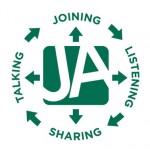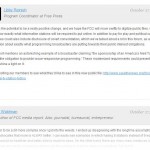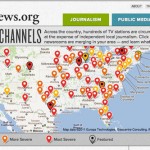Blog:
JA reports: TV forum results and what’s next

There is conversation for conversation’s sake, and there is conversation with purpose. JA forums are designed to be relevant, interesting, informative, and useful. In this final of three posts analyzing our recent forum on the Value of Local TV News, we explore a set of tangible artifacts we’ve distilled from the conversation, and envision how the community might act on those takeaways.
As the first large scale JA forum, the conversation was an exciting experiment in many ways. The first reporting back post covers the “why” behind this particular forum, plus an overview of performance. The second offers the “how” – our methodology to deliver online engagement.
We welcome your comments on all aspects of our analysis as we continue to learn.

People Talking About: What is the value of local TV news?
After distilling this forum to its essence in multiple ways, I am so appreciative of the people who joined this conversation! Thank you. Your breadth and depth of expertise, your passion about the value of TV news, and your on-the-ground research and experience gave deep insight to big questions that will affect the future of local TV news. The conversation attracted people across and beyond the TV news industry, including:
- broadcast news directors
- new media news practitioners
- industry support groups
- union reps
- academic experts
- professional association members
- advocates
- policy crafters
- cross sector professionals
- news anchors and correspondents
- technologists/entrepreneurs
- think tank members
- legal professionals
As moderator, observer and one of the organizers, I’d venture to say most everyone participating believes TV is a powerful tool with the potential to anchor local communities. This is despite major challenges, including industry trends away from investigative news, staff turnover and newsroom consolidation. It is in part because of the industry’s aggressive pursuit of staying easily accessible as the world goes increasingly online and mobile.
But the forum also captured a sense of discontent with local TV news now. Questions popped up about jobs, about coverage choices, about station ownership and finances, about national policy and about local innovation. The forum revealed a shared sense of urgency around this question:
How can local TV news better serve the new media necessity – to truly engage people, not as viewers, but as participants in telling their community’s story?
That question emerged through points made in several key conversation threads:
 Conversation around station and newsroom consolidation revealed concerns that fewer subjects might be covered, that fewer points of view might be offered, and that jobs would be lost as newsrooms consolidate and staff is let go. It also showed indications that deliberate content repackaging can broaden the news audience, and suggested consolidation could provide opportunities for better news coverage – if savings from ending duplicative costs were reinvested in news.
Conversation around station and newsroom consolidation revealed concerns that fewer subjects might be covered, that fewer points of view might be offered, and that jobs would be lost as newsrooms consolidate and staff is let go. It also showed indications that deliberate content repackaging can broaden the news audience, and suggested consolidation could provide opportunities for better news coverage – if savings from ending duplicative costs were reinvested in news.- Conversation around experiments showed that TV remains a megaphone, with the over-the-air, online, and increasingly mobile ability to reach a broad swath of people. Major television brands are finding traction by integrating TV, radio and internet news in an effort to match consumers’ routines and keep people engaged as news develops over the day.
- Conversation around money indicated that TV isn’t imploding like daily papers, which may contribute to less exploration of new financial models. It also added to a strong current of discontent with the major non-commercial model, public broadcasting, for a lack of consistent, quality local TV news. (In response, some examples of public broadcasting success stories were cited and held up as possible models.)
- Conversation around policy showed that the FCC still holds power to shape the future of local television news, but lamented the limited influencers of the regulatory process.
From conversation, to imagination
The hopes and insights participants brought to the forum laid the groundwork for some tangible artifacts that could grow out of the community to help support TV news as a local resource.
In response to consolidation: There are different opinions about the impact newsroom consolidation has and will have on the breadth and depth of information available to communities. It could be useful to develop several simple evaluation sheets for use inside and outside newsrooms. For example:
- A community checklist of questions to ask when two stations are considering combining. It might include gathering information such as: Who owns the stations? How many hours of local news are broadcast? How many journalists are employed? How many beats are regularly assigned and covered?
- Regular surveys of both the internal newsroom and external audience to quantifiably track and compare data the impact of a TV station in a community. For example, surveys could find the number of new news viewers, the amount of time journalists spend per story, the number of different versions of one story that are shown across broadcast properties, the average number of years journalists spend at the station, the number of stories to which community input was solicited and used. This information would be most useful if it were public, and community views on the content were publicly posted to reveal trends and perception of value.
Sharing lessons from experimentation: Stations are experimenting with partnerships, including partnerships with local newspapers and startup investigative news sites. They are also experimenting with technology, including mobile broadcast, and with new ways to gather community input. Conversation in the forum suggested certain tools might help that.
- An informative grid showing examples of different types of community input, what is involved in gathering it successfully, and how much it affects the final story could be enormously useful as a resource for stations across the country.
- A space to, frankly and routinely, share information about different collaborative experiments could benefit local new media and local TV reporting alike.
- Research into the costs and benefits of collaboration could provide helpful guidance to shape where that path leads. Questions to explore might include fiscal costs, a comparison of results between collaborative and competitive journalism, tracking who makes the most money in collaborative partnerships and which kinds of collaborations are yielding the greatest return for the communities served.
- The further development of replicable, universal, easily integrated technology for people to share information with TV stations will widen participation in reporting the news.
Examining the books: Forum participants cited few examples of innovation in financial models for TV. The conversation revealed discontent with the local news service public television provides. Long term, it could be helpful for local television news to:
- See at least one experiment with community ownership, as proposed by the president of the Media Council Hawaii.
- Mobilize public broadcast supporters in a campaign to identify desires for local television news.
- Explore how standards of service, community guidelines and best practices to advance the public interest might be collaboratively identified and shared, designing these considerations into revenue model design and assessment.
Following policy: When the forum discussion turned to a new FCC transparency policy, the agency’s power became clear. However, forum participants revealed a low expectation, built through experience, that people not directly involved in television news would make any effort to affect policy. Some tangible changes that could affect people’s expectations of the agency:
- The new FCC rule on transparency, discussed during the forum, could make local news viewers more aware of what groups or companies are quietly influencing the news through pay-to-play ads. It could also make communities more aware of TV station public service work or broadcasts defined as “in the public interest.”
- An app to easily comment on FCC policy, promoted by TV stations or included in mobile broadcasts, could potentially increase public input into agency decisions affecting broadcast television as TV increasingly expands into the mobile and online markets.
What next?
It’s tempting to say the JA forum on the Value of Local TV News raised more questions than answers. More accurately, it revealed a number of issues that those who value the power and potential of local broadcasting are confronting. Acting to create any one of the tangible response tools imagined above would take time and effort. From conversation, to imagination, to evolution. Local TV news is not dying. What’s next is its next incarnation.














Weigh In: Remember to refresh often to see latest comments!
0 comments so far.